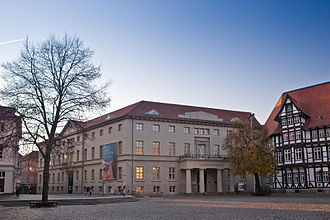Vieweg publishing house
| Vieweg publishing house | |
|---|---|
| legal form | GmbH |
| founding | 1786 |
| resolution | 2008 |
| Reason for dissolution | Merger to form Vieweg + Teubner Verlag |
| Seat | 1786–1799 Berlin 1799–1974 Braunschweig 1974–2008 Wiesbaden |
| Branch | Book and magazine publisher |
| Website | http://www.springer.com/springer+vieweg |
The Vieweg Verlag was a German specialist publisher in Wiesbaden until 2008 . It was founded in Berlin in 1786 by Friedrich Vieweg and was based in Braunschweig from 1799 to 1974 . In 1974 the head office was relocated to Wiesbaden. In April 2008 he was integrated into the newly founded company Vieweg + Teubner Verlag .
Publishing program
The publishing house focuses on mechanical engineering, electrical engineering, mathematics, construction, IT and natural sciences. According to the publisher, more than 30 Nobel Prize winners have published with Vieweg over the years, including Albert Einstein , Otto Hahn and Max Planck . In addition to specialist and textbooks, the publisher publishes around 15 specialist journals (some with its own online presence) and also offers seminars and conferences in the ViewegTechnology Forum. In the publishing program, for example, is water management .
history
The bookseller Friedrich Vieweg (1761–1835) from Halle an der Saale founded a publishing bookstore in Berlin in 1786 and moved it to Braunschweig in 1799, where his father-in-law Johann Heinrich Campe also ran a school bookstore since 1786, which emerged from the local orphanage bookstore. With the support of Duke Karl Wilhelm Ferdinand , who wanted to set up a bookseller's fair and exchange here, he built the Vieweg house on Burgplatz as a residential and commercial building.

In addition to Campe's school bookstore, Vieweg also took over a printing company, which he expanded to include a type foundry and a playing card factory. He set himself apart from the competition through high demands on typographic quality. His most famous publishing work was Goethe's lyrical epic Hermann and Dorothea . Campe's “Robinson the Younger” (an adaptation of Robinson Crusoe ) was also published by Viewegs Verlag and was still a popular article 100 years later.
In 1825, Vieweg's eldest son, Eduard Vieweg (1797–1869), joined the publishing bookstore Friedrich Vieweg and Son as a partner . He modernized the printing works and added a paper factory to the publishing house in 1836 in Lehr-Wendhausen , where the family had leased Wendhausen Castle for 99 years from 1836 . In 1841 he created his own woodcut workshop and, encouraged by his friend Justus von Liebig , geared the publishing house more towards the natural sciences, technology and mathematics.
In addition to standard scientific works such as the Concise Dictionary of Chemistry , which was initially published by Hermann Kolbe and later by Hermann Christian von Fehling , he also published books that were intended to ensure further dissemination and practical application of scientific knowledge. Eduard Vieweg was also politically active as the publisher of the " German National Newspaper from Braunschweig and Hanover " (1831–1840) and the Deutsche Reichs-Zeitung (1848–1866).
His son Heinrich Vieweg (1826–1890) modernized the publishing house and the paper mill and built up an extensive art collection. After his death, his widow Helene managed the publishing house until 1909, supported by her daughter of the same name and son-in-law Bernhard Tepelmann. In 1922 the publishing house was converted into a family stock company.
In 1966 Pergamon Verlag in Oxford bought the company, in 1974 it was incorporated into the Bertelsmann publishing group and moved from Braunschweig to Wiesbaden. The headquarters in Braunschweig is today the main building of the Braunschweigisches Landesmuseum .
In April 2008 the publishing house was merged with BG Teubner Verlag , which also belongs to the GWV Fachverlagen (now Springer Fachmedien Wiesbaden) .
In 2012 the resulting Vieweg + Teubner Verlag was merged with the German-language technical program of Springer Verlag and renamed Springer Vieweg .
Publishing archive
Since the end of 1999 the archive of the Vieweg publishing house, which is closely associated with Braunschweig, has been back in Braunschweig - now in the possession of the Braunschweig University Library .
Others
In the 1780s and 1790s there was also a publisher in Berlin (Friedrich) Wilhelm Vieweg, called the Younger, while Friedrich Vieweg added the elder from 1787 , probably to differentiate himself from him. It is not known whether they were related, but they were certainly not brothers.
literature
- Adolf Dreyer (ed.): Friedrich Vieweg & Son in 150 Years of German Intellectual History, 1786–1936. Vieweg, Braunschweig 1936 DNB 361806256 .
- Frank Lube, Ulrich Wechsler, Rudolf Wendorff: The publishing house Friedrich Vieweg & Son 1786–1986. The speeches in the Vieweg House in Braunschweig on April 25, 1986. Vieweg, Braunschweig 1986, ISBN 3-528-00201-8 .
- Andreas Lütjen: The Viewegs. The example of a middle-class family in Braunschweig 1825 - 1921 . Monsenstein and Vannerdat, Münster, 2012, ISBN 978-3-86991-530-2 (also dissertation at the University of Halle (Saale) 2011).
- Rolf Hagen : Vieweg (publishing house and family). In: Luitgard Camerer , Manfred Garzmann , Wolf-Dieter Schuegraf (eds.): Braunschweiger Stadtlexikon . Joh. Heinr. Meyer Verlag, Braunschweig 1992, ISBN 3-926701-14-5 , p. 234 f .
- Paul Zimmermann : Vieweg . In: Allgemeine Deutsche Biographie (ADB). Volume 39, Duncker & Humblot, Leipzig 1895, pp. 689-693.
Web links
- Springer Vieweg's website
- Web presence of Vieweg + Teubner Verlag on viewegteubner.de
- Literature from and about Verlag Friedr. Vieweg and son in the catalog of the German National Library
- Vieweg Verlag on universal_lexikon.deacademic.com
- The Vieweg archives of the Braunschweig University Library
Individual evidence
- ↑ springer.com
- ^ Friedr. Vieweg & Sohn in Braunschweig, 1786–1911, published on the occasion of the company's hundred and twenty-five years of existence, founded in April 1786 . F. Vieweg, Braunschweig 1911, p. VII – VIII ( archive.org ).